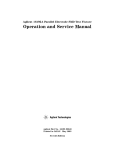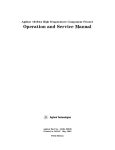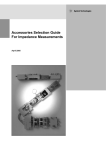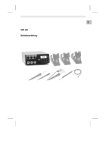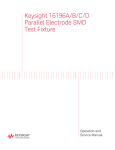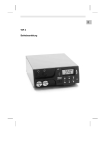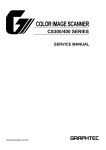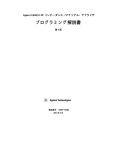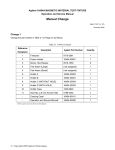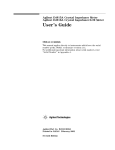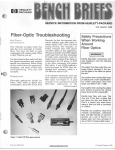Download Operation and Service Manual
Transcript
Agilent 16191A Side Electrode SMD Test Fixture Operation and Service Manual Agilent Part No. 16191-90040 Printed in JAPAN May 2003 Sixth Edition Notice The information contained in this document is subject to change without notice. This document contains proprietary information that is protected by copyright. All rights are reserved. No part of this document may be photocopied, reproduced, or translated to another language without the prior written consent of the Agilent Technologies. Agilent Technologies Japan, Ltd. Component Test PGU-Kobe 1-3-2, Murotani, Nishi-ku, Kobe-shi, Hyogo, 651-2241 Japan c Copyright Agilent Technologies Japan, Ltd. 1993, 1996, 1999, 2000, 2001, 2003 Manual Printing History The manual printing date and part number indicate its current edition. The printing date changes when a new edition is printed. (Minor corrections and updates that are incorporated at reprint do not cause the date to change.) The manual part number changes when extensive technical changes are incorporated. December 1993 : : : : : : : : : : : : : : : : : : : : : : : : : : : : : : : : : : : : : : First Edition (part number: 16191-90000) June 1996 : : : : : : : : : : : : : : : : : : : : : : : : : : : : : : : : : : : : : : : : : Second Edition (part number: 16191-90010) December 1999 : : : : : : : : : : : : : : : : : : : : : : : : : : : : : : : : : : : : : : Third Edition (part number: 16191-90010) September 2000 : : : : : : : : : : : : : : : : : : : : : : : : : : : : : : : : : : : : : Forth Edition (part number: 16191-90020) August 2001 : : : : : : : : : : : : : : : : : : : : : : : : : : : : : : : : : : : : : : : : : Fifth Edition (part number: 16191-90030) May 2003 : : : : : : : : : : : : : : : : : : : : : : : : : : : : : : : : : : : : : : : : : : : : Sixth Edition (part number: 16191-90040) iii Safety Summary The following general safety precautions must be observed during all phases of operation, service, and repair of this instrument. Failure to comply with these precautions or with specic WARNINGS given elsewhere in this manual violates safety standards of design, manufacture, and intended use of the instrument. The Agilent Technologies assumes no liability for the customer's failure to comply with these requirements. DO NOT Operate In An Explosive Atmosphere Do not operate the instrument in the presence of ammable gasses or fumes. Operation of any electrical instrument in such an environment constitutes a safety hazard. Keep Away From Live Circuits Operating personnel must not remove instrument covers. Component replacement and internal adjustments must be made by qualied maintenance personnel. Do not replace components with the power cable connected. Under certain conditions, dangerous voltages may exist even with the power cable removed. To avoid injuries, always disconnect power and discharge circuits before touching them. DO NOT Service Or Adjust Alone Do not attempt internal service or adjustment unless another person, capable of rendering rst aid and resuscitation, is present. DO NOT Substitute Parts Or Modify Instrument Because of the danger of introducing additional hazards, do not substitute parts or perform unauthorized modications to the instrument. Return the instrument to a Agilent Technologies Sales and Service Oce for service and repair to ensure the safety features are maintained. Dangerous Procedure Warnings Warnings, such as the example below, precede potentially dangerous procedures throughout this manual. Instructions contained in the warnings must be followed. Warning Dangerous voltages, capable of causing death, are present in this instrument. Use extreme caution when handling, testing, and adjusting this instrument. The voltage levels found in this test xture when used with the intended instruments do not warrant more than normal safety precautions for operator safety. iv Operating Precaution Do not exceed the operating input power, voltage, and current level and signal type appropriate for the instrument being used, refer to your instrument's operation manual. Caution Electrostatic discharge (esd) can damage the highly sensitive microcircuits in your instrument. ESD damage is most likely to occur as the test xtures are being connected or disconnected. Protect them from ESD damage by wearing a grounding strap that provides a high resistance path to ground. Alternatively, ground yourself to discharge any static charge built-up by touching the outer shell of any grounded instrument chassis before touching the test port connectors. Never touch the test clip contacts. Use a work station equipped with an anti-static work surface. Certication Agilent Technologies certies that this product met its published specications at the time of shipment from the factory. Agilent Technologies further certies that its calibration measurements are traceable to the United States National Institute of Standards and Technology, to the extent allowed by the Institution's calibration facility, or to the calibration facilities of other International Standards Organization members. Warranty This Agilent Technologies instrument product is warranted against defects in material and workmanship for a period of one year from the date of shipment, except that in the case of certain components listed in Instrument Specications of this manual, the warranty shall be for the specied period. During the warranty period, Agilent Technologies will, at its option, either repair or replace products which prove to be defective. For warranty service or repair, this product must be returned to a service facility designated by Agilent Technologies. Buyer shall prepay shipping charges to Agilent Technologies and Agilent Technologies shall pay shipping charges to return the product to Buyer. However, Buyer shall pay all shipping charges, duties, and taxes for products returned to Agilent Technologies from another country. Agilent Technologies warrants that its software and rmware designated by Agilent Technologies for use with an instrument will execute its programming instruction when property installed on that instrument. Agilent Technologies does not warrant that the operation of the instrument, or software, or rmware will be uninterrupted or error free. v Limitation Of Warranty The foregoing warranty shall not apply to defects resulting from improper or inadequate maintenance by Buyer, Buyer-supplied software or interfacing, unauthorized modication or misuse, operation outside of the environmental specications for the product, or improper site preparation or maintenance. No other warranty is expressed or implied. Agilent Technologies specically disclaims the implied warranties of merchantability and tness for a particular purpose. Exclusive Remedies The remedies provided herein are buyer's sole and exclusive remedies. Agilent Technologies shall not be liable for any direct, indirect, special, incidental, or consequential damages, whether based on contract, tort, or any other legal theory. Assistance Product maintenance agreements and other customer assistance agreements are available for Agilent Technologies products. For any assistance, contact your nearest Agilent Technologies Sales and Service Oce. Addresses are provided at the back of this manual. vi Safety Symbols General denitions of safety symbols used on equipment or in manuals. Instruction manual symbol: the product is marked with this symbol when it is necessary for the user to refer to the instruction manual in order to protect against damage to the instrument. Indicates dangerous voltage (terminals fed from the interior by voltage exceeding 1000 volts must be so marked). Protective conductor terminal. For protection against electrical shock in case of a fault. Used with wiring terminals to indicate the terminal which must be connected to ground before operating equipment. Low-noise or noiseless, clean ground (earth) terminal. Used for a signal common, as well as providing protection against electrical shock in case of fault. A terminal marked with this symbol must be connected to ground in the manner described in the installation (Operation) manual, and before operating the equipment. Frame or chassis terminal. A connection to the frame (chassis) of the equipment which normally includes all exposed metal structures. Alternating current (power line). Direct current (power line). Alternating or direct current (power line). Warning denotes a hazard. It calls attention to a procedure, practice, condition or the like, which, if not correctly performed or adhered to, could result in injury or death to personnel. Caution sign denotes a hazard. It calls attention to a procedure, practice, condition or the like, which, if not correctly performed or adhered to, could result damage to or destruction of part or all of the product. Note denotes important information. It calls attention to a procedure, practice, condition or the like, which is essential to highlight. vii R is a U.S. registered trademark of the Bunker Ramo Corporation. APC-7 viii Contents 1. General Information Introduction . . . . . . . . . . . . . . . Manual Summary . . . . . . . . . . . Product Description . . . . . . . . . . . Applicable Instruments . . . . . . . . . . Options Available . . . . . . . . . . . . Accessories Supplied . . . . . . . . . . . Specications . . . . . . . . . . . . . . Supplemental Performance Characteristics Residual Inductance of the Shorting Bar . . . . . . . . . . . . . . . . . . . . . . . . . . . . . . . . . . . . . . . . . . . . . . . . . . . . . . . . . . . . . . . . . . . . . . . . . . . . . . . . . . . . . . . . . . . . . . . . . . . . . . . . . . . . . . . . . . . . . . . . . . . . . . . . . . . . . . . . . . . . . . . . . . . . . . . . . . . . . . . . . . . . 1-1 1-1 1-1 1-1 1-2 1-2 1-3 1-3 1-4 Introduction . . . . . . . . . . . . . . . . . . . . . . . Initial Inspection . . . . . . . . . . . . . . . . . . . . . Connecting the Test Fixture for Use . . . . . . . . . . . . Repackaging the Test Fixture For Shipment . . . . . . . . Measurement Error Correcting Function for Each Instrument . . . . . . . . . . . . . . . . . . . . . . . . . . . . . . . . . . . . . . . . . . . . . . . . . . 2-1 2-1 2-3 2-4 2-4 . . . . . . . . . . . . . . . . . . . . . . . . . . . . . . . . . . . . . . . . . . . . . . . . . . . . . . . . . . . . . . . . . . . . . . . . . . . . . . . . 3-1 3-1 3-2 3-3 3-3 3-5 3-6 3-7 Introduction . . . . . . . . . . . . . . . . . . . . . . . . . . . General Information . . . . . . . . . . . . . . . . . . . . . . . Assembly Replacement . . . . . . . . . . . . . . . . . . . . . . Disassembly and Assembly Procedure . . . . . . . . . . . . . . Test Stage, Pressure Arm, and Locking Arm Assembly Removal: Replaceable Parts . . . . . . . . . . . . . . . . . . . . . . . Troubleshooting . . . . . . . . . . . . . . . . . . . . . . . . . Open Impedance Check . . . . . . . . . . . . . . . . . . . . Short Impedance Check . . . . . . . . . . . . . . . . . . . . Short Impedance Repeatability Check . . . . . . . . . . . . . . . . . . . . . . . . . . . . . . . . . . . . . . . . . . . . . . . . . . . . . . . . . . . . . . . . . . . . . . . . . . 4-1 4-1 4-3 4-3 4-3 4-4 4-10 4-10 4-10 4-11 2. Preparation for Use 3. Operation Introduction . . . . . . . . . . . . . . . . . . . . . . Operating Flow . . . . . . . . . . . . . . . . . . . . Overview . . . . . . . . . . . . . . . . . . . . . . . How to set the SHORT condition, and the OPEN condition Setting the SHORT condition . . . . . . . . . . . . . Setting the OPEN condition . . . . . . . . . . . . . How to connect the DUT . . . . . . . . . . . . . . . . Adjusting the Pressure Arm Stroke . . . . . . . . . . . 4. Service . . . . . . . . Contents-1 Figures 1-1. 1-2. 2-1. 2-2. 3-1. 3-2. 4-1. Applicable DUT Size . . . . . . . . . . . . . . . . . . . . Simulation Setup . . . . . . . . . . . . . . . . . . . . . 16191A Product Overview . . . . . . . . . . . . . . . . . R Connector (4291B) Connecting the Test Fixture with APC-7 16191A Test Fixture Overview . . . . . . . . . . . . . . . Arm Stroke Adjustment . . . . . . . . . . . . . . . . . . Replaceable Parts for Test Stage . . . . . . . . . . . . . . . . . . . . . . . . . . . . . . . . . . . . . . . . . . . . . . . . . . . . . . . . . . . . . . . . . . . . . . 1-4 1-5 2-2 2-3 3-2 3-7 4-8 . . . . . . . . . . . . . . . . . . . . . . . . . . . . . . . . . . . . . . . . . . . . . . . . . . . . . . . . . . . . . . . . . . . . . . . . . . . . . . . . . . . . . . . . . . . . . . . . . . . . . . . . . . . . . . . . 1-2 1-4 1-5 2-2 2-4 4-2 4-4 4-5 4-6 4-7 4-9 4-10 4-11 4-11 Tables 1-1. 1-2. 1-3. 2-1. 2-2. 4-1. 4-2. 4-3. 4-4. 4-5. 4-6. 4-7. 4-8. 4-9. Furnished Accessories . . . . . . . . . . . . . . . . . . . Option 701 Shorting Device Residual Inductance (Typical) . . Option 010 Shorting Device Residual Inductance (Typical) . . 16191A Contents . . . . . . . . . . . . . . . . . . . . . Measurement Error Correcting Functions for Each Instrument 16191A Product Overview . . . . . . . . . . . . . . . . . Replaceable Parts for Main Assembly . . . . . . . . . . . . Replaceable Parts for Main Assembly (without Top Cover) . . Replaceable Parts for Locking Arm Assembly . . . . . . . . Replaceable Parts for Pressure Arm Assembly . . . . . . . . Replaceable Parts for Test Stage Assembly . . . . . . . . . . Open Impedance Value Guideline . . . . . . . . . . . . . . Short Impedance Value Guideline . . . . . . . . . . . . . . Short Impedance Repeatability Guideline . . . . . . . . . . Contents-2 1 General Information Introduction The purpose of this manual is to enable you to use your 16191A Side Electrode SMD Test Fixture eciently and condently. Manual Summary This manual contains the following: The specications of the 16191A (see this chapter). Installing the 16191A (see Chapter 2). Operating the 16191A (see Chapter 3). Ordering replaceable parts for the 16191A (see Chapter 4). Product Description The 16191A is used to measure a side electrodes surface mount device (SMD) with high repeatability. Applicable Instruments The 16191A has been designed to operate specically with the following LCR meters and impedance analyzers: You can directly connect the 16191A to: You can use the 16191A with 43961A: You can use the 16191A with 41951A: You can use the 16191A with RF adapter 42942A: You can use the 16191A with RF adapter 16085B: You can use the 16191A with RF adapter 16099A: 4191A, 4291B, E4991A 4395A (option 010), 4396A/B (option 010) 4195A 4294A 4284A1 4194A with 41941A2 1 The 4284A is a typical instrument. Other 4-terminal pair instruments that can be used with the 16085B are also applicable. 2 The 4194A with 41941A is a typical instrument. Other instruments that can be used with the 16099A are also applicable. General Information 1-1 Options Available The following option is supplied for the 16191A: Option 010 Add industry standard size short bar set Option 701 Short bars set (1x1x2.4, 1.6x2.4x2, 3.2x2.4x2.4, 4.5x2.4x2.4)mm Option 710 Add the magnifying lens and tweezers Accessories Supplied The following accessories are supplied with the 16191A: Table 1-1. Furnished Accessories Description Part Number Operation and Service Manual Option 701 Case for shorting devices Option 010*1 Magnifying lens*2 Tweezers*2 Wrench P/N 16191-90040 P/N 16191-29001 P/N 16191-29002 P/N 16191-29003 P/N 16191-29004 P/N 1540-0692 P/N 16191-29005 P/N 16191-29006 P/N 16191-29007 P/N 16191-29008 P/N 16193-60002 P/N 8710-2081 P/N 8710-1181 Quantity 1 1 1 1 1 1 1 1 1 1 1 1 1 Option 010 sizes are the same as industry standard (EIA/EIAJ) SMD sizes. This short bar set has the following SMD sizes included : 1005(mm)/0402(inch), 1608(mm)/0603(inch), 2012(mm)/0805(inch), 3216(mm)/1206(inch). Order option 010 if the SMD that is to be measured has the same size as the EIA/EIAJ sizes. *2 Furnished with the option 710 *1 1-2 General Information Specications This section lists the complete 16191A specications. These specications are the performance standards and limits against which the 16191A is tested. When shipped from the factory, the 16191A meets the following specications: Maximum DC Bias Voltage : : : : : : : : : : : : : : : : : : : : : : : : : : : : : : : : : : : : : : : : : : : : : : : : : : : : : : : : : : : : : : : 6 40V Operating Temperature : : : : : : : : : : : : : : : : : : : : : : : : : : : : : : : : : : : : : : : : : : : : : : : : : : : : : : : : : : 055 to +85 C Operating Humidity (@wet bulb temperature <40 C) : : : : : : : : : : : : : : : : : : : : : : : : : : : : : : : : : : : : : : : : : : : : : : : : : : : : : : : : : : : : : : : : : : : : : : : : : : : : : : 15 % to 95 % RH Non-operating Temperature : : : : : : : : : : : : : : : : : : : : : : : : : : : : : : : : : : : : : : : : : : : : : : : : : : : : : 055 to +85 C Non-operating Humidity (@wet bulb temperature <65 C) : : : : : : : : : : : : : : : : : : : : : : : : : : : : : : : : : : : : : : : : : : : : : : : : : : : : : : : : : : : : : : : : : : : : : : : : : : : : : : : : : Up to 90 % RH Weight : : : : : : : : : : : : : : : : : : : : : : : : : : : : : : : : : : : : : : : : : : : : : : : : : : : : : : : : : : : : : : : : : : : : : : : : : : : : : : : : : : : : : 500 g Dimension : : : : : : : : : : : : : : : : : : : : : : : : : : : : : : : : : : : : : : : : : : : : : : : : : : : : : : 150(W) 2 70(H) 2 110(D) [mm] Supplemental Performance Characteristics This section lists supplemental performance characteristics. Supplemental performance characteristics are not specications, but are typical characteristics included as additional information for the operator. Supplemental performance characteristics are not guaranteed. Frequency Range : : : : : : : : : : : : : : : : : : : : : : : : : : : : : : : : : : : : : : : : : : : : : : : : : : : : : : : : : : : : : : : : : : DC to 2 GHz Applicable DUT size (see Figure 1-1) : : : : : : : : : : : : : : : : : : : : : : : : : : : : : : : : : : : : : : : : : : 2 mm to 12 mm Option 701 shorting device size P/N 16191-29001 P/N 16191-29002 P/N 16191-29003 P/N 16191-29004 : : : : : : : : : : : : : : : : : : : : : : : : : : : : : : : : : : : : : : : : : : : : : : : : : : : : : : : : : : : : 1 2 1 2 2.4 [mm] : : : : : : : : : : : : : : : : : : : : : : : : : : : : : : : : : : : : : : : : : : : : : : : : : : : : : : : : : : 1.6 2 2.4 2 2 [mm] : : : : : : : : : : : : : : : : : : : : : : : : : : : : : : : : : : : : : : : : : : : : : : : : : : : : : : : : 2.4 2 2.4 2 3.2 [mm] : : : : : : : : : : : : : : : : : : : : : : : : : : : : : : : : : : : : : : : : : : : : : : : : : : : : : : : : 2.4 2 2.4 2 4.5 [mm] Option 010 shorting device size P/N 16191-29005 : : : : : : : : : : : : : : : : : : : : : : : : : : : : : : : : : : : : : : : : : : : : : : 1.0(L) 2 0.5(W) 2 0.5(H) [mm] P/N 16191-29006 : : : : : : : : : : : : : : : : : : : : : : : : : : : : : : : : : : : : : : : : : : : : : : 1.6(L) 2 0.8(W) 2 0.8(H) [mm] P/N 16191-29007 : : : : : : : : : : : : : : : : : : : : : : : : : : : : : : : : : : : : : : : : : : : : : : 2.0(L) 2 1.2(W) 2 0.8(H) [mm] P/N 16191-29008 : : : : : : : : : : : : : : : : : : : : : : : : : : : : : : : : : : : : : : : : : : : : : : 3.2(L) 2 1.6(W) 2 0.8(H) [mm] Electrical length (when the length between electrodes is 2 mm) : : : : : : : : : : : : : : : : : : : : : 14.0 mm Additional Error3 : : : : : : : : : : : : : : : : : : : : : : : : : : : : : : : : : : : : : : : : : : : : : : : : : : : : : : : : : : : : : : : : : : 1.5 2 f2 [%] Repeatability3 (for inductive component) : : : : : : : : : : : : : : : : : : : : : : : : : : : : : : : : : : : : : : : : : : : : : : : : : 30 + 250 2 f [m ] (impedance of 30 m , 40 pH) : : : : : : : : : : : : : : : : : : : : : : : : : : : : : : : : : : : : : : : : : : : : : : : : : : : : : : : : : : : : : : : : : : : : : : : : : : : : : : : : 2 + 30 2 f [S] (admittance of 2 S, 5 fF) 3 f: frequency (GHz) General Information 1-3 Figure 1-1. Applicable DUT Size Residual Inductance of the Shorting Bar The usual method to compensate the test xture's residual inductance is to let SHORT = 0H. In this method, the measurement result is the relative value of the measured impedance to the shorting bar's impedance. The short bar's residual inductance as a result of its size and shape is not estimated. On the other hand, there is a denition method to let SHORT = x H. In this method, the measurement result is the absolute value of the device's impedance. The short bar's residual inductance as a result of its size and shape is estimated under specic conditions and is used as a reference value. This method, is useful for devices with values which are close to the short conditions of the measurement system. The reference inductance values presented Table 1-2 and Table 1-3 were simulated as the relative dierence to a disk-type 0 termination on either the 7 mm or the 3.5 mm connector. The measurement of these short bars under other conditions than shown below cannot reproduce the reference inductance values. Table 1-2. Option 701 Shorting Device Residual Inductance (Typical) Shorting Bar l [mm] d [mm] h [mm] Oset [mm] Connector Inductance (Typical) P/N 16191-29001 P/N 16191-29002 P/N 16191-29002 P/N 16191-29002 P/N 16191-29003 P/N 16191-29004 1-4 General Information 1 1.6 2 2.4 3.2 4.5 2.4 2.4 2.4 2 2.4 2.4 1 2 1.6 1.6 2.4 2.4 0.75 0.45 0.25 1.3 0.9 0 3.5 mm 3.5 mm 3.5 mm 7 mm 7 mm 7 mm 0.2 nH 0.2 nH 0.2 nH 0.7 nH 0.6 nH 0.6 nH Table 1-3. Option 010 Shorting Device Residual Inductance (Typical) Shorting Bar l [mm] d [mm] h [mm] Oset [mm] Connector Inductance (Typical) P/N 16191-29005 P/N 16191-29006 P/N 16191-29007 P/N 16191-29008 1.0 1.6 2.0 3.2 0.5 0.8 1.2 1.6 0.5 0.8 0.8 0.8 0.75 0.45 1.5 0.9 3.5 mm 3.5 mm 7 mm 7 mm 0.5 nH 0.4 nH 0.9 nH 0.8 nH Figure 1-2. Simulation Setup General Information 1-5 2 Preparation for Use Introduction This chapter explains how to install the 16191A. The topics include the following: Initial inspection. Connecting the test xture for use. Repackaging the test xture for shipment. Measurement error correcting function for each instrument. Initial Inspection The side electrode SMD test xture has been carefully inspected before being shipped from the factory. It should be in perfect physical condition, no scratches, dents or the like. It should also be in perfect electrical condition. Verify this by carefully performing an incoming inspection to check the side electrode SMD test xture set for signs of physical damage and missing contents. If any discrepancy is found, notify the carrier and Agilent Technologies. Your Agilent Technologies sales oce will arrange for repair and replacement without waiting for the claim to be settled. Inspect the shipping container for damage. Keep the shipping materials until the inspection is completed. Verify that the shipping container contains everything shown in Figure 2-1 and listed in Table 2-1. Inspect the exterior of the 16191A for any signs of damage. Preparation for Use 2-1 . Figure 2-1. 16191A Product Overview Table 2-1. 16191A Contents Description Agilent Part Number 1 Test xture 2 Operation and Service Manual1 3 Shorting device2 (12122.4[mm]) (1.622.422[mm]) (2.422.423.2[mm]) (2.422.424.5[mm]) 4 Case for shorting device 5 Magnifying lens34 6 Tweezers4 7 Wrench Quantity 16191A P/N 16191-90020 P/N 16191-29001 P/N 16191-29002 P/N 16191-29003 P/N 16191-29004 P/N 1540-0692 P/N 16193-60002 P/N 8710-2081 P/N 8710-1181 1 Operation and Service Manual is not shown in Figure 2-1. 2 Contained if you ordered the 16191A option 701. 3 The magnifying lens is packed separately from the 16191A body. Connect it as shown in Figure 2-1. 4 Contained if you ordered the 16191A option 710. 2-2 Preparation for Use 1 1 1 1 1 1 1 1 1 1 Connecting the Test Fixture for Use Some instruments require an adapter to be connected to the 16191A (see Note \Applicable Instruments" in Chapter 1). R connector plane before connecting test xture. See 1. Calibrate your analyzer at the APC-7 Table 2-2 for the applicable error correcting function. After calibration, disconnect any R connector. standards from the APC-7 R connector. 2. Place the xture on the APC-7 R connector. 3. Tighten (turn counterclockwise) the coupling nut of the APC-7 R Connector (4291B) Figure 2-2. Connecting the Test Fixture with APC-7 Preparation for Use 2-3 Repackaging the Test Fixture For Shipment If shipment to an Agilent Technologies service center is required, each test xture should be repackaged using the original factory packaging materials. If this material is not available, comparable packaging materials may be used. Wrap the side electrode SMD test xture in heavy paper and pack in anti-static plastic packing material. Use sucient shock absorbing material on all sides of the 16191A to provide a thick, rm cushion and to prevent movement. Seal the shipping container securely and mark it FRAGILE. Measurement Error Correcting Function for Each Instrument Each LCR meter or analyzer has measurement error correcting functions. Table 2-2 shows the functions of the instrument that can be used for calibration, setting the electrical length, and Open/Short/Load compensation. Table 2-2. Measurement Error Correcting Functions for Each Instrument Instrument 4291B 4191A 4194A with 16085B 4195A with 41951A 4194A with 41941A/B, 16099A 4194A with 16085B Calibration Electrical length Calibration OPEN SHORT LOAD LOW-LOSS Capacitor1 Calibration 0S 0 50 No capability Selecting Test Fixture Port Extension Calibration OPEN SHORT LOAD Calibration 0S 0 50 Calibration 0S 0 50 Port Extension (Port 1 or Port 2) 0 S OFFSET 0 OFFSET No capability No capability Compensation ZERO OPEN Compensation ZERO SHORT No capability No capability Compensation ZERO OPEN Compensation ZERO SHORT No capability Electrical Length No capability 1 According to demand for precise measurement 2-4 Preparation for Use OPEN Compensation SHORT Compensation SHORT Compensation LOAD Compensation1 No capability No capability No capability OPEN Compensation LOAD Compensation OPEN Correction SHORT Correction LOAD Correction1 3 Operation Introduction This chapter describes how to use the test xture and the measurement error correcting techniques for the test xture. Operating Flow Before performing a measurement, you have to compensate for the residual error of the test xture by using the measurement error correcting functions. Perform the following steps when measuring the DUT: The 16191A has inherent stray capacitance, residual inductance, and residual resistance that aect the measurement. To compensate for these residuals and thus minimize their eect on measurement accuracy, the measurement instrument's OPEN and SHORT compensation capabilities must be used. ( 7 indicates procedures in the following pages.) Described in Chapter 2. The 16191A's electrical length is 14.0 mm (typical value). To set the electrical length, see your analyzer's Operation Manual. To set the xture and devices for xture compensation, see: \How to set the SHORT condition, and the OPEN condition" These procedures show how to set the test xture for the OPEN/SHORT/LOAD compensation procedure. For how to measure OPEN/SHORT/LOAD, see the Operation Manual supplied with your analyzer. (You can omit LOAD compensation.) 7 To connect the DUT, see: 7 \How to connect the DUT" 3 The compensating functions are dierent for each instrument. See Table 2-2 and perform the listed functions. Operation 3-1 Overview Figure 3-1. 16191A Test Fixture Overview Electrodes (Pressure) arm Pressure adjustment Arm latch Positioner (Horizontal) positioning knob (Horizontal) locking knob (Device) scale Shorting device These are connected to the device. Fixes the device. Adjusts the pressure applied to the device. Latches the arm o to turn up and down the arm. Slides to x an electrode. Opens and closes the positioner. Locks the positioner. Used for rough adjustment of the positioner. (Not shown in Figure 3-1) Used for short compensation. If you ordered the option 010 or 701, four types of shorting devices are supplied with the 16191A. Use one that has dimensions similar to the DUT. When making a shorting device of same dimensions as your DUT, very low residual impedance and a high conductivity metal (that is not easily corroded) must be used to construct the shorting device. (It must also be clean.) Magnifying lens Warning 3-2 Operation (Not shown in Figure 3-1) Used when placing a small device within the electrodes. DO NOT look at the sun through the magnifying glass. DO NOT operate or leave the magnifying glass under direct sunlight. How to set the SHORT condition, and the OPEN condition Setting the SHORT condition The names of each part are listed above. 1. 1 Latch o the arm latch. 2 Hold up the pressure arm. 2. Loosen knob A 3. Adjust knob B to t the shorting device to the device scale. Operation 3-3 4. Place the shorting device on the electrode and turn 5. Verify that the shorting device contacts the electrodes securely. knob B for ne adjustment. 6. Tighten knob A. 8. Verify that pressure arm presses the shorting device. 3-4 Operation 7. 1 Press the arm latch. 2 Turn down the pressure arm. Setting the OPEN condition 1. Place the DUT on the electrolde just as you set the 2. Remove the DUT from the electrodes. shorting device in the short compensation. 3. 1 Press the arm latch. 2 Turn down the pressure arm. Operation 3-5 How to connect the DUT 1. 1 Latch o the arm latch. 2 Hold up the pressure 2. Place the DUT on the electrodes. arm. 3. 1 Press the arm latch. 2 Turn down the pressure 4. Verify that pressure arm presses the DUT. arm. 3-6 Operation Adjusting the Pressure Arm Stroke Depending on the device size, change the pressure arm stroke, so that the arm properly presses the device. 1. Loosen the screws with the wrench. 2. Adjust the arm stroke. 3. Tighten the screws. Figure 3-2. Arm Stroke Adjustment Operation 3-7 4 Service Introduction This chapter covers the following subjects: General Information Assembly Replacement Disassembly Procedure for Main Assembly Replaceable Parts Troubleshooting Warning Caution These servicing instructions are for use by qualied personnel only. Do NOT perform any servicing (other than that contained in the operating section) unless you are qualied to do so. When you repair the 16191A, put on lint-free groves to avoid contaminating inner parts of the 16191A. Agilent Technologies supplies lint-free groves (Agilent part number 9300-0163). General Information Table 4-1 shows all items included with the 16191A Side Electrode SMD Test Fixture. Service 4-1 Table 4-1. 16191A Product Overview Reference Designator 1 2 3 4 5 6 7 8 9 - Agilent Part Number (not assigned) 16193-60002 8710-1181 8710-2081 16191-29001 16191-29002 16191-29003 16191-29004 1540-0692 16191-29021 16191-90040 Qty. 1 Contained if you ordered the 16191A option 710. 2 Contained if you ordered the 16191A option 701. 3 Not shown in the gure. 4-2 Service 1 1 1 1 1 1 1 1 1 1 1 Description Main Assembly Magnifying Glass1 Wrench Tweezers1 Shorting Device (12122.4 mm)2 Shorting Device (1.622.422 mm)2 Shorting Device (2.422.423.2 mm)2 Shorting Device (2.422.424.5 mm)2 Case for shorting devices Styrofoam Holder3 Operation and Service Manual3 Assembly Replacement This section includes Disassembly and Assembly Procedures and Replacement Parts for the Main Assembly. Disassembly and Assembly Procedure This section contains the information required to disassemble and assemble the Main Assembly. Test Stage, Pressure Arm, and Locking Arm Assembly Removal: 1. Remove the four at-head screws (marked with \1" in Table 4-2). Then remove the top cover of the Pressure Arm Assembly. 2. Loosen the knob of the Locking Arm (marked with \13" in Table 4-3). 3. Remove the four screws (marked with \1" in Table 4-3). Then remove the Test Stage Assembly (marked with \15" in Table 4-3). 4. Remove the bottom cover \2", two springs \16", two shafts \3" and \14", and Locking Arm Assembly \13" (see Table 4-3). 5. Remove the Pressure Arm Assembly (marked with \4" in Table 4-3). Service 4-3 Replaceable Parts Table 4-2 through Table 4-6 show and list the replaceable parts for the 16191A. The parts listed can be ordered from your nearest Agilent Technologies Oce. Ordering information must include the Agilent part number and the quantity required. Table 4-2. Replaceable Parts for Main Assembly Reference Designator 1 2 3 4-4 Service Agilent Part Number 0515-0914 16191-04001 (not assigned) Qty. 4 1 1 Description Screw Flat Head Top Cover Main Assembly without Top Cover Table 4-3. Replaceable Parts for Main Assembly (without Top Cover) Reference Designator 1 2 3 4 5 6 7 8 9 10 11 12 13 14 15 16 Agilent Part Number 0515-1550 16191-04003 16191-23001 (not assigned) 16191-23003 16191-25005 16191-23010 16191-24017 16191-24016 16191-04002 3030-0007 16191-23004 (not assigned) 16191-23002 (not assigned) 1460-2372 Qty. 4 1 1 1 1 4 2 1 1 1 4 1 1 1 1 2 Description Screw Pan Head M3L8 Bottom Cover Shaft Pressure Arm Assembly Shaft Bushing Gear Screw Horizontal Positioning Knob Bottom Cover Set Screw Shaft Locking Arm Assembly Shaft Test Stage Assembly Spring Service 4-5 Table 4-4. Replaceable Parts for Locking Arm Assembly Reference Designator 1 2 3 4-6 Service Agilent Part Number 16191-24005 16191-24019 0510-0015 Qty. 1 1 1 Knob Holder E-ring Description Table 4-5. Replaceable Parts for Pressure Arm Assembly Reference Designator 1 2 3 4 5 6 7 8 9 10 11 12 Agilent Part Number 0515-1050 0510-0976 16191-25003 16191-24018 16191-29011 16191-25006 16191-01203 16191-00602 16191-24006 16191-24010 PPNR007783 16191-23005 Qty. 3 2 1 1 1 2 1 1 1 1 1 1 Description Screw Socket Head M3L8 Screw Pan Head M2L6 Holder Block Spring Washer Angle Plate Screw Pin Spring Plunger Service 4-7 Figure 4-1. Replaceable Parts for Test Stage 4-8 Service Reference Designator 1 2 3 4 5 6 7 8 9 10 11 12 13 14 15 16 Table 4-6. Replaceable Parts for Test Stage Assembly Agilent Part Number Qty. Description 0515-0914 16191-00201 16191-24022 16191-24014 16191-25004 16191-24015 0510-0045 16191-24021 0510-0952 16191-00601 0515-2421 16191-25002 16191-60001 16191-24004 1250-0907 16193-24001 1 1 1 1 1 1 1 1 3 1 1 1 1 1 1 1 Screw Flat Head M3L6 Table Screw Guide Guide Contact-L E-Ring Nut Screw Flat Head M2L4 Ground Plate Screw Pan Head M1.4L3 Guide Contact Assembly Contact Collet Flange Service 4-9 Troubleshooting This section includes the functional check procedure used to troubleshoot the 16191A Side Electrode SMD Test Fixture. Open Impedance Check 1. Adjust the electrode distance for connecting the 1.62222.4 mm Shorting Device (16191-29002). 2. Place the xture on the calibrated APC-7 terminal of the 4291B RF Impedance Analyzer. 3. Set the 4291B RF Impedance Analyzer as follows: Measurement Parameter Cp (parallel capacitance) Start Frequency 100 MHz Stop Frequency 1 GHz OSC Level 0.12 V Number of Point 2 Point Averaging Factor 16 Point Averaging ON 4. Perform a single sweep measurement. 5. Read Cp value at 100 MHz and 1 GHz. The guideline for the open impedance value is as follows: Table 4-7. Open Impedance Value Guideline Parameter Frequency Guideline (absolute value) Cp 100 MHz 770 fF 6 400 fF Cp 1 GHz 770 fF 6 400 fF Short Impedance Check 1. After the Open Impedance Check is completed, put the 1.62222.4 mm Shorting Device (16191-29002) between the electrodes. 2. Set the 4291B RF Impedance Analyzer as follows: Measurement Parameter Ls (series inductance) Start Frequency 100 MHz Stop Frequency 1 GHz OSC Level 0.12 V Number of Point 2 Point Averaging Factor 16 Point Averaging ON 3. Make a single sweep measurement. 4. Read Ls value at 100 MHz and 1 GHz. The guideline of the short impedance value is as follows: 4-10 Service Table 4-8. Short Impedance Value Guideline Parameter Frequency Guideline (absolute value) Ls 100 MHz 3 nH 6 1 nH Ls 1 GHz 3 nH 6 1 nH Short Impedance Repeatability Check 1. After the Short Impedance Check is completed, remove the Shorting Device and put it back on the same place again. 2. Make a single sweep measurement with the same measurement conditions. 3. Read Ls value at 100 MHz and 1 GHz and check the value is within the Short Impedance Value Guideline described in Table 4-8. 4. Calculate the dierence between the rst Ls measurement value and second Ls measurement value at each frequency. The guideline of the short impedance repeatability is as follows: Table 4-9. Short Impedance Repeatability Guideline Parameter Frequency Guideline (dierence) Ls 100 MHz 6 45 pH Ls 1 GHz 6 20 pH Service 4-11 REGIONAL SALES AND SUPPORT OFFICES For more information about Agilent Technologies test and measurement products, applications, services, and for a current sales office listing, visit our web site: http://www.agilent.com/find/tmdir. You can also contact one of the following centers and ask for a test and measurement sales representative. 11/29/99 United States: Agilent Technologies Test and Measurement Call Center P.O.Box 4026 Englewood, CO 80155-4026 (tel) 1 800 452 4844 Canada: Agilent Technologies Canada Inc. 5150 Spectrum Way Mississauga, Ontario L4W 5G1 (tel) 1 877 894 4414 Europe: Agilent Technologies Test & Measurement European Marketing Organization P.O.Box 999 1180 AZ Amstelveen The Netherlands (tel) (31 20) 547 9999 Japan: Agilent Technologies Japan Ltd. Call Center 9-1, Takakura-Cho, Hachioji-Shi, Tokyo 192-8510, Japan (tel) (81) 426 56 7832 (fax) (81) 426 56 7840 Latin America: Agilent Technologies Latin American Region Headquarters 5200 Blue Lagoon Drive, Suite #950 Miami, Florida 33126 U.S.A. (tel) (305) 267 4245 (fax) (305) 267 4286 Australia/New Zealand: Agilent Technologies Australia Pty Ltd 347 Burwood Highway Forest Hill, Victoria 3131 (tel) 1-800 629 485 (Australia) (fax) (61 3) 9272 0749 (tel) 0 800 738 378 (New Zealand) (fax) (64 4) 802 6881 Asia Pacific: Agilent Technologies 24/F, Cityplaza One, 1111 King’s Road, Taikoo Shing, Hong Kong (tel) (852)-3197-7777 (fax) (852)-2506-9284











































